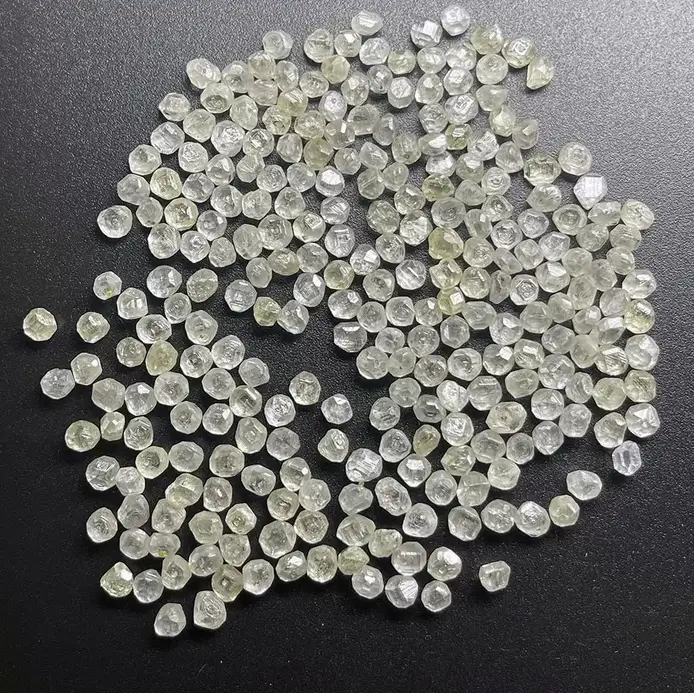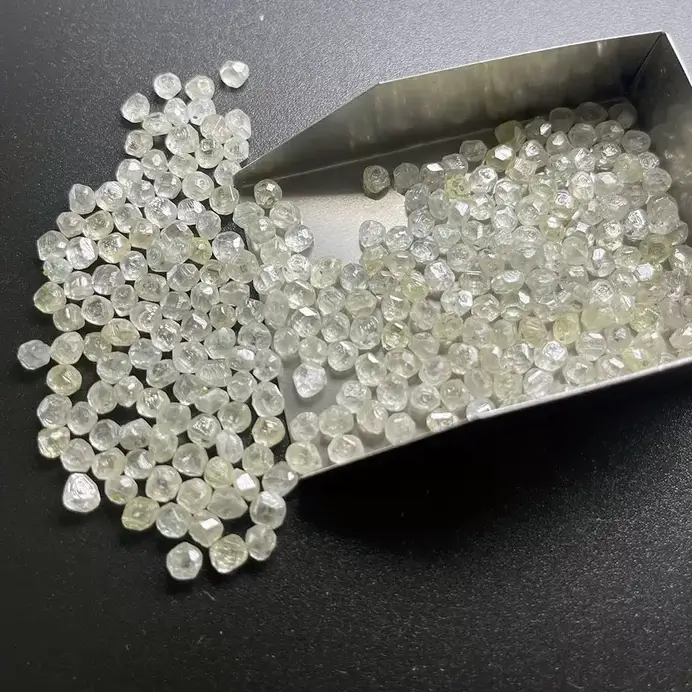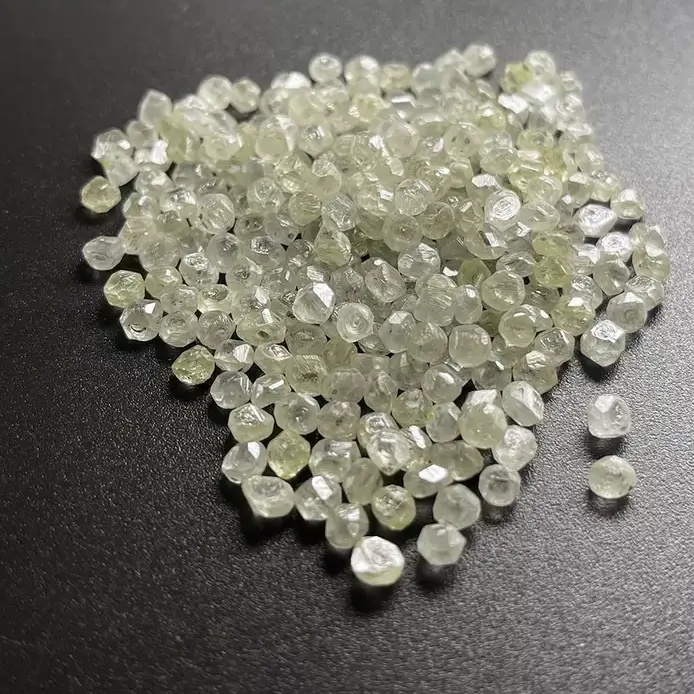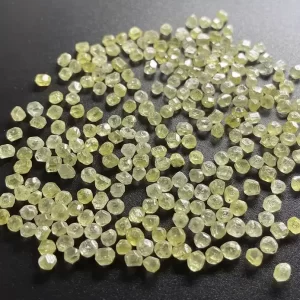0.4ct 0.5ct 0.6ct VS SI Lab Grown Colored Diamonds Light Yellow Lab Diamonds
Lab Grown Colored Diamonds Description
Lab grown diamonds, also known as lab created diamonds or synthetic diamonds, are diamonds produced in a controlled laboratory environment. The diamonds cultivated in the laboratory have the same physical, optical and chemical properties as those mined by the earth. Laboratory diamonds have the same crystal structure of carbon atoms as natural diamonds, which makes them have the same superior hardness and spectacular beauty. The only difference between laboratory diamonds and mined diamonds is how they are made. The diamonds mined are formed in the earth’s crust, while the diamonds made in the laboratory are made in the laboratory.
There are two methods of diamond growth in laboratory: chemical vapor deposition (CVD) and high pressure high temperature (HPHT).
In the HPHT method, diamond seeds (diamond fragments) are placed under extremely high pressure and temperature, similar to the way diamonds grow on the ground. The diamond seeds are put into the bulk carbon and placed under these conditions. The carbon melts and combines with the diamond seeds to form diamond crystals after cooling.
In CVD, they take a diamond seed (usually HPHT diamond) and place it in a chamber. They filled the chamber with carbon gas, which ionized into a plasma like substance, breaking down the bonded molecules. The carbon from these leaves forms around the seeds and begins to crystallize.
Light Yellow Lab Diamonds Vs Vivid Yellow Lab Diamonds
While the light yellow diamonds are the most popular, they are not as rare as their vivid yellow cousins. In fact, they are harder to find and can be quite expensive, which makes lab-grown yellow diamonds more expensive. This article will discuss the differences between light yellow and vivid yellow lab diamonds, as well as GIA grading. Here, we will take a look at some of the benefits and drawbacks of each.
Cost
When it comes to diamonds, the carat weight is important to consider when determining the cost of a diamond. Since the color scale is linear, one can expect the cost of a one-carat diamond to be considerably higher than that of a two-carat yellow diamond. However, you should keep in mind that the actual weight can vary greatly. If you’re not sure how to compare the weights of two diamonds, here are some tips to help you decide which one is best for your budget and personal tastes.
Before you start comparing lab diamonds to natural diamonds, you should consider their quality and their cost. Natural diamonds are extremely rare, and lab-created diamonds are relatively inexpensive. They are also more ethical because they don’t require mining to create them. Moreover, lab-grown diamonds have a more realistic appearance than natural diamonds, which means that you can get a much larger stone for a lower price.
The main difference between fancy and lab-grown diamonds is their color. Light yellow diamonds have a higher price than fancy yellows, and intense yellow diamonds are more expensive than their white counterparts. Besides being cheaper, lab-grown diamonds are also more difficult to produce than natural ones, and their color is virtually identical to that of the real thing. This means that if you want to surprise your loved one with an unusual and stunning yellow diamond, opt for a lab-grown gem instead.
Fancy yellow diamonds are slightly more expensive than lab-grown ones, as they are a cut above fancy light diamonds. Fancy intense yellow diamonds are typically more than six-carats and can cost anywhere from $3,000 to $8000. However, if you’re looking for a one-carat yellow diamond with a deep yellow hue, you can expect to pay anywhere from $4,500 to $5,500 for it.
Quality
Fancy yellow diamonds are extremely rare, so if you want something unique but are on a budget, consider purchasing a lab-grown light yellow diamond. The exact reason for this is unclear, but certain chemical elements, such as nitrogen, increase the color of diamonds. Nitrogen is added during the growth process, and the amount will affect the final shade of yellow. In general, lab-grown yellow diamonds take a week or two to grow to their full size.
The grading process for lab grown diamonds is very similar to the grading process for mined diamonds, which focuses on four important characteristics: color, cut, and clarity. The cut is responsible for the brilliance of a diamond, while clarity refers to the absence of defects. The carat is a measure of the size and weight of a diamond. A laboratory-grown light yellow diamond will be graded accordingly to reflect the four facets of a high-quality gem.
The quality of lab-grown light yellow diamonds is generally comparable to that of their natural counterparts. Natural light yellow diamonds are rare and expensive, so lab-grown yellow diamonds are a popular choice for modern couples. Lab-grown light yellow diamonds are also much less expensive than their natural counterparts. And while lab-grown yellow diamonds may be of lesser quality, they are still highly sought-after.
Because of the advanced technology used to create lab diamonds, the cost per carat has fallen considerably over the past several years. And the cost per carat of lab diamonds continues to fall, as more competitors enter the market and quality improves. A lab-grown light yellow diamond with the same 4Cs as a natural diamond can be manufactured in as little as two weeks, while a natural diamond can take billions of years to form.
Size
Colorless lab grown diamonds have always been a popular choice, but light yellow has recently become a trend. These diamonds are created in labs and are considered fancy colors. The price of fancy colors in natural diamonds tends to be much higher than light yellow, because of their rarity. Fortunately, lab grown diamonds can consistently produce beautiful colors in small quantities that are affordable. Lightbox colored lab grown diamonds come in blush pink and icy blue hues, and they are exquisitely saturated and tonally aligned.
The process of creating these diamonds is an extremely complex process, and the end result is a flawless diamond. A light yellow lab grown diamond can be as large as three carats. They are remarkably similar to natural diamonds, including their chemical composition and crystal structure. This means that they are able to show the same sparkle as an organic diamond. Due to their unique manufacturing process, these diamonds are classified as chemical vapor deposition (CVD) or high-pressure, high-temperature (HPHT) diamonds.
In terms of color, light yellow lab grown diamonds are typically colorless. However, there are a few key differences between natural and lab-grown diamonds. A light yellow lab grown diamond is not as clear as a natural diamond, but its color is usually less noticeable. It’s possible that the lab grown diamond has some inclusions, which are small flaws in the diamond that form during the growth process. These inclusions can include foreign matter or a tiny crack that got into the diamond’s structure during growth. A natural diamond on the other hand can have tiny cracks and a range of color grades.
A natural light yellow diamond is more expensive than a lab grown one. This is the reason that many consumers choose lab-grown diamonds. They are more affordable and unique. However, it is difficult to find a light yellow diamond. If you’re looking for an elegant diamond, lab-grown diamond may be the perfect choice for you. And remember to check the color grading report before making a purchase.
GIA grading
GIA grading of Light Yellow lab diamonds can be confusing if you don’t know what to look for. This grading scale is used for fancy yellow diamonds. This is because diamonds come in a wide range of colors, including grey, white, and yellow. They can even be brown or red. Each color is graded using a different letter. This scale allows for slight variations, but it can be misleading if the diamond is too light.
GIA is the most trusted laboratory in the world. They use advanced technology and a team of gemologists to grade diamonds. Their labs are located in major trading centers around the world. They use a system that combines scientific knowledge with the latest equipment to ensure that diamonds meet the highest standards of quality and rarity. GIA has thirteen labs worldwide to ensure that diamonds meet the highest standards and are of the highest possible quality.
GIA’s system measures the absence of color in diamonds. The color grades begin with D for colorless diamonds and go all the way down to Z for light yellow or brown diamonds. Though the color difference is subtle, it can affect a diamond’s quality and price significantly. The cut quality is another key determinant of diamond sparkle. The better the cut quality, the more dazzling the diamond.
Fancy yellow lab diamonds are harder to find than regular diamonds. They cost less, but the intensity of color is very intense. The yellow color is rare and expensive, so this type of diamond is worth a try if you’re looking for a unique and unusual diamond for an engagement ring. But don’t forget that light yellow diamonds are not necessarily less valuable than fancy yellow diamonds. If you’re still unsure about the difference, consider the following information.
Natural diamond vs. lab-grown diamonds
While lab-grown diamonds are cheaper, they have lower sparkle and are made from the same chemicals as their natural counterparts. If you are looking for a sparkly diamond but are unsure of the difference between a natural and lab-grown diamond, Dr. Shigley explains the differences between these two types. Besides the different growth morphology, both types are cut and graded the same way.
Lab-grown diamonds are man-made diamonds, a process that mimics the process of natural diamonds. This process involves a process called diamond synthesis and uses carbon-rich gas to create a diamond that is nearly identical. A natural diamond takes billions of years to form, and a lab-grown diamond is made in a lab within a few weeks. Natural diamonds usually contain nitrogen, while lab-grown diamonds do not.
There is a difference between a natural diamond and a lab-grown diamond, according to Brandon Cook, director of marketing at Clean Origin, a lab-grown diamond company. He explained that the difference between the two kinds of diamonds is not only price, but durability. But you shouldn’t feel intimidated by the fact that a diamond was created by a lab. The difference between a natural diamond and a lab-grown diamond is not so drastic, though.
The natural diamond is more expensive than a lab-grown one, but they are not necessarily inferior. Compared to real diamonds, lab-grown diamonds are more affordable than their natural counterparts. In fact, lab-grown diamonds can have comparable qualities. So, the choice is yours. But when it comes to diamond prices, which should you buy? Consider the pros and cons of both.
0.4ct 0.5ct 0.6ct VS SI Lab Grown Colored Diamonds Light Yellow Lab Diamonds

















